Mechanistic Analysis and Multi-Factor Coupling Optimization of Temporary Plugging Fracturing in Shale Oil Horizontal Wells: A Case Study from the Sichuan Basin, China
Abstract
1. Introduction
2. Optimization of Temporary Plugging Fracturing Parameters
2.1. Introduction to Numerical Simulation Methods and Models
2.2. Optimization of Temporary Plugging Agent Amount
2.3. Optimization of the Addition Time of Temporary Plugging Agent
2.4. Optimization of the Frequency of Temporary Plugging Agent Additions
3. Field Application
4. Conclusions
Author Contributions
Funding
Data Availability Statement
Conflicts of Interest
References
- Zhao, W.; Hu, S.; Hou, L.; Tao, Y.; Xin, L.; Guo, B.; Zhi, Y. Types and resource potential of continental shale oil in China and its boundary with tight oil. Pet. Explor. Dev. 2020, 47, 1–11. [Google Scholar] [CrossRef]
- Hu, S.; Zhao, W.; Hou, L.; Zhi, Y.; Rukai, Z.; Songtao, W.; Bin, B.; Xu, J. Development potential and technical strategy of continental shale oil in China. Pet. Explor. Dev. 2020, 47, 877–887. [Google Scholar] [CrossRef]
- Jin, Z.; Zhu, R.; Liang, X.; Shen, Y. Several issues worthy of attention in current lacustrine shale oil exploration and development. Pet. Explor. Dev. 2021, 48, 1471–1484. [Google Scholar] [CrossRef]
- Wang, Y.; Lv, Z. Composite stimulation technology for improving fracture length and conductivity of unconventional reservoirs. Front. Phys. 2023, 11, 1181302. [Google Scholar] [CrossRef]
- Wang, Y.; Fan, Y.; Wang, X. Study on migration law of multiscale temporary plugging agent in rough fractures of shale oil reservoirs. Front. Phys. 2023, 11, 1228006. [Google Scholar] [CrossRef]
- Qun, L.E.I.; Yun, X.U.; Bo, C.A.I.; Baoshan, G.; Xin, W.; Guoqiang, B.I.; Hui, L.I.; Shuai, L.I.; Bin, D.; Haifeng, F.U.; et al. Progress and prospects of horizontal well fracturing technology for shale oil and gas reservoirs. Pet. Explor. Dev. 2022, 49, 191–199. [Google Scholar]
- Wang, Y.; Fan, Y.; Li, S.; Lv, Z.; He, R.; Wang, L. A new fracturing method to improve stimulation effect of Marl tight oil reservoir in Sichuan basin. Processes 2023, 11, 3234. [Google Scholar] [CrossRef]
- Gao, Y.; Yang, Z.; Gao, F.; Li, N.; Deng, S.; Wu, S. Mechanical study and key parameter optimization of temporary plugging fracturing in tight reservoirs. J. Phys. Conf. Series 2023, 2610, 012043. [Google Scholar] [CrossRef]
- Jiang, T.X.; Xu, Y.; Li, Z.P.; Wang, X.; Cai, B. A new method of selective separate layer fracturing by delivering seal balls in pad stage and its application. Nat. Gas Ind. 2009, 29, 88–90. [Google Scholar]
- Wang, Y.; Sun, B.; Wang, T.; Hao, Z.; Wang, B. Quantitative Investigation of Fracture Apertures during Temporary Plugging and Diverting Fracturing. Sustainability 2023, 15, 14664. [Google Scholar] [CrossRef]
- Zhang, Z.; Zhang, S.; Zou, Y.; Ma, X.; Li, N.; Liu, L. Experimental investigation into simultaneous and sequential propagation of multiple closely spaced fractures in a horizontal well. J. Pet. Sci. Eng. 2021, 202, 108531. [Google Scholar] [CrossRef]
- Zou, Y.; Ma, X.; Zhang, S. Numerical modeling of fracture propagation during temporary-plugging fracturing. SPE J. 2020, 25, 1503–1522. [Google Scholar] [CrossRef]
- He, W.; Liu, B.; Zhang, J.; Bai, L.; Tian, S.; Chi, Y. Geological characteristics and key scientific and technological problems of Gulong shale oil in Songliao Basin. Earth Sci 2023, 48, 49–62. [Google Scholar]
- Fang, R.; Jiang, Y.; Luo, Y.; Wang, Z.; Jiang, C.; Li, S.; Qi, L.; Yan, X. Hydrocarbon geological characteristics and factors controlling hydrocarbon accumulation of Jurassic Da’anzhai continental shale. Minerals 2023, 14, 11. [Google Scholar] [CrossRef]
- Wang, Y.; Fan, Y.; Zhou, C.; Luo, Z.; Chen, W.; He, T.; Fang, H.; Fu, Y. Research and application of segmented acid fracturing by temporary plugging in ultradeep carbonate reservoirs. ACS Omega 2021, 6, 28620–28629. [Google Scholar] [CrossRef]
- Shen, H.; Yang, L.; Han, H.; Wang, Y.; Xing, J.; Xue, S.; Liu, H. New fields, new types and resource potentials of oil-gas exploration in southern Songliao Basin. Acta Pet. Sin. 2023, 44, 2104. [Google Scholar]
- Guo, Q.; Chen, X.; Liuzhuang, X.; Yang, Z.; Zheng, M.; Chen, N.; Mi, J. Evaluation method for resource potential of shale oil in the Triassic Yanchang Formation of the Ordos Basin, China. Energy Explor. Exploit. 2020, 38, 841–866. [Google Scholar] [CrossRef]
- Li, Y.; Sun, P.; Liu, Z.; Rong, L.; Wang, J.; Zhang, M. Characteristics of Upper Permian oil shale and analysis of the resource development potential in the Lucaogou Formation in the Junggar Basin, northern Bogda Mountains, Northwest China. Oil Shale 2020, 37, 207–223. [Google Scholar] [CrossRef]
- Alqahtani, N.; Alzubaidi, F.; Armstrong, R.T.; Swietojanski, P.; Mostaghimi, P. Machine learning for predicting properties of porous media from 2d X-ray images. J. Pet. Sci. Eng. 2020, 184, 106514. [Google Scholar] [CrossRef]
- Li, Q.; Li, Q.; Cao, H.; Wu, J.; Wang, F.; Wang, Y. The Crack Propagation Behaviour of CO2 Fracturing Fluid in Unconventional Low Permeability Reservoirs: Factor Analysis and Mechanism Revelation. Processes 2025, 13, 159. [Google Scholar] [CrossRef]
- Zhou, H.; Wu, X.; Song, Z.; Zheng, B.; Zhang, K. A review on mechanism and adaptive materials of temporary plugging agent for chemical diverting fracturing. J. Pet. Sci. Eng. 2022, 212, 110256. [Google Scholar] [CrossRef]
- Wang, Z.; Yang, L.; Gao, R.; Xu, G.; Liu, Z.; Mo, S.; Fan, M.; Wang, X. Numerical analysis of zipper fracturing using a non-planar 3D fracture model. Front. Earth Sci. 2022, 10, 808183. [Google Scholar] [CrossRef]
- Zheng, C.; Wang, D.; Shen, B.; Wang, Q.; Liu, X.; Sun, D.; Yu, B.; Zhou, F.; Zhang, J. An experimental study of the temporary plugging mechanisms of rough fractures in hot dry rocks under a high temperature. Powder Technol. 2023, 427, 118687. [Google Scholar] [CrossRef]
- Yuan, L.; Zhou, F.; Li, B.; Gao, J.; Yang, X.; Cheng, J.; Wang, J. Experimental study on the effect of fracture surface morphology on plugging efficiency during temporary plugging and diverting fracturing. J. Nat. Gas Sci. Eng. 2020, 81, 103459. [Google Scholar] [CrossRef]
- Zhang, R.; Hou, B.; Tan, P.; Muhadasi, Y.; Fu, W.; Dong, X.; Chen, M. Hydraulic fracture propagation behavior and diversion characteristic in shale formation by temporary plugging fracturing. J. Pet. Sci. Eng. 2020, 190, 107063. [Google Scholar] [CrossRef]
- Zhang, Y.; Yu, R.; Yang, W.; Tian, Y.; Shi, Z.; Sheng, C.; Song, Y.; Du, H. Effect of temporary plugging agent concentration and fracturing fluid infiltration on initiation and propagation of hydraulic fractures in analogue tight sandstones. J. Pet. Sci. Eng. 2022, 210, 110060. [Google Scholar] [CrossRef]
- Zhang, B.; Pan, Z.; Cao, L.; Xie, J.; Chu, S.; Jing, Y.; Lu, N.; Sun, T.; Li, C.; Xu, Y. Measurement of wellbore leakage in high-pressure gas well based on the multiple physical signals and history data: Method, technology, and application. Energy Sci. Eng. 2024, 12, 4–21. [Google Scholar] [CrossRef]
- Chang, X.; Wang, X.; Yang, C.; Guo, Y.; Wei, K.; Hu, G.; Jiang, C.; Li, Q.; Dou, R. Simulation and optimization of fracture pattern in temporary plugging fracturing of horizontal shale gas wells. Fuel 2024, 359, 130378. [Google Scholar] [CrossRef]
- Lu, C.; Luo, Y.; Li, J.; Chen, C.; Xiao, Y.; Liu, W.; Lu, H.; Guo, J. Numerical analysis of complex fracture propagation under temporary plugging conditions in a naturally fractured reservoir. SPE Prod. Oper. 2020, 35, 0775–0796. [Google Scholar] [CrossRef]
- Wang, M.; Wang, J.; Cheng, F.; Chen, X.; Yang, X.; Lv, W.; Wang, B. Diverter plugging pattern at the fracture mouth during temporary plugging and diverting fracturing: An experimental study. Energy Rep. 2022, 8, 3549–3558. [Google Scholar] [CrossRef]
- Tang, X.; Zhu, H.; Che, M.; Wang, Y. Complex fracture propagation model and plugging timing optimization for temporary plugging fracturing in naturally fractured shale. Pet. Explor. Dev. 2023, 50, 152–165. [Google Scholar] [CrossRef]
- Li, Y.; Zhang, Q.; Zou, Y. Experimental Investigation of the Growth Law of Multi-Fracture during Temporary Plugging Fracturing within a Stage of Multi-Cluster in a Horizontal Well. Processes 2022, 10, 637. [Google Scholar] [CrossRef]
- Geng, S.; He, X.; Zhu, R.; Li, C. A new permeability model for smooth fractures filled with spherical proppants. J. Hydrol. 2023, 626, 130220. [Google Scholar] [CrossRef]
- Geng, S.; Wang, Q.; Zhu, R.; Li, C. Experimental and numerical investigation of Non-Darcy flow in propped hydraulic fractures: Identification and characterization. Gas Sci. Eng. 2024, 121, 205171. [Google Scholar] [CrossRef]
- Wang, L.; Yang, J.; Peng, J.; Han, H.; Wang, Y.; Lv, Z. Temporary Plugging Agent Evaluation Technology and Its Applications in Shale Reservoirs in the Sichuan Basin. Processes 2023, 11, 2799. [Google Scholar] [CrossRef]
- Geng, S.; Li, C.; Li, Y.; Zhai, S.; Xu, T.; Gong, Y.; Jing, M. Pressure transient analysis for multi-stage fractured horizontal wells considering threshold pressure gradient and stress sensitivity in tight sandstone gas reservoirs. Gas Sci. Eng. 2023, 116, 205030. [Google Scholar] [CrossRef]
- Li, Y.; He, F.; Yu, W. Simulation of temporary plugging effect in hydraulic fracturing with complex natural fractures. In Proceedings of the ARMA US Rock Mechanics/Geomechanics Symposium, Virtual, 18–25 June 2021; ARMA: Alexandria, VA, USA, 2021. ARMA-2021-1651. [Google Scholar]
- Wang, X.H.; Zhang, F.S.; Yin, Z.R.; Weng, D.W.; Liang, H.B.; Zhou, J.P.; Xu, B. Numerical investigation of refracturing with/without temporarily plugging diverters in tight reservoirs. Pet. Sci. 2022, 19, 2210–2226. [Google Scholar] [CrossRef]

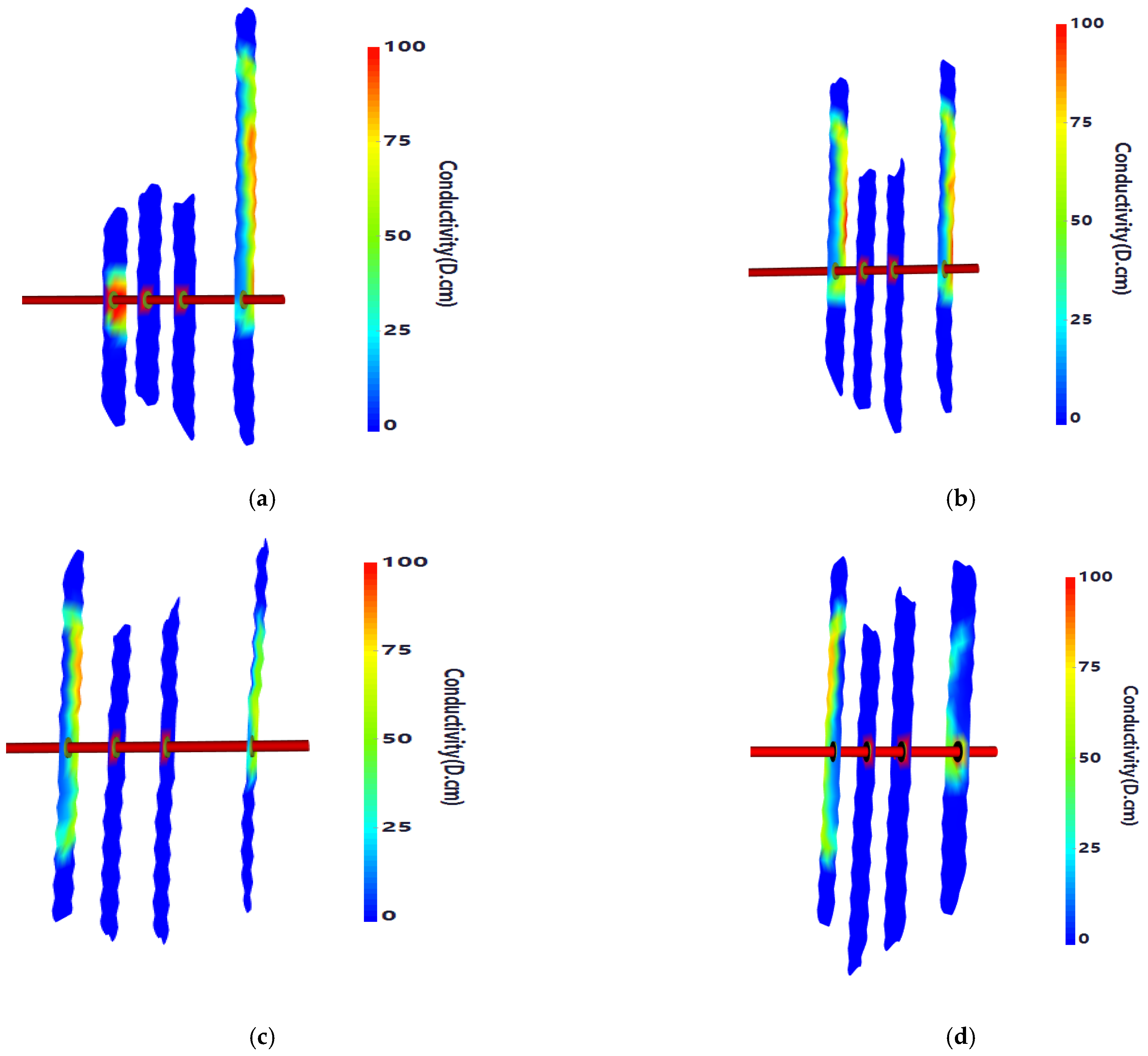
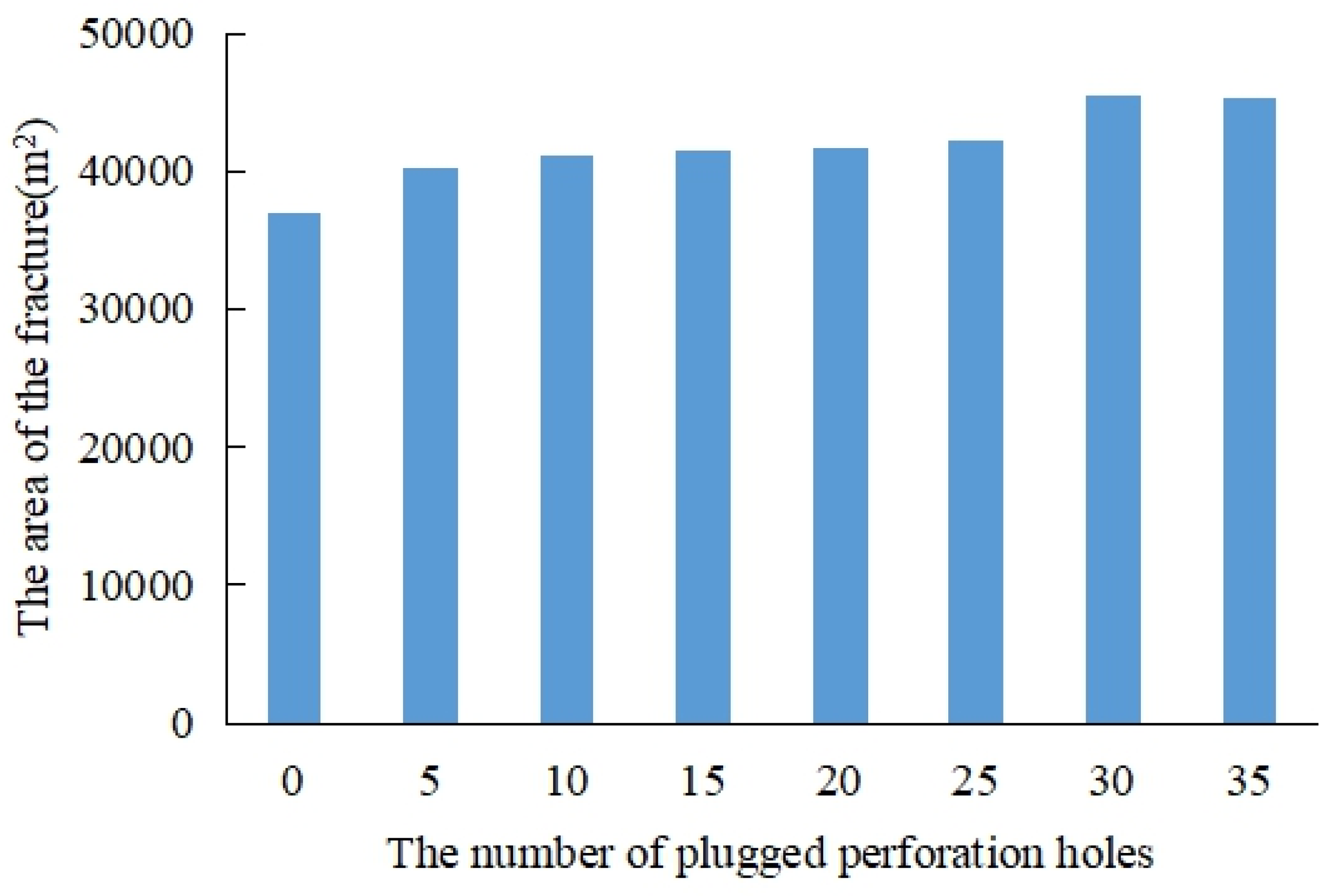
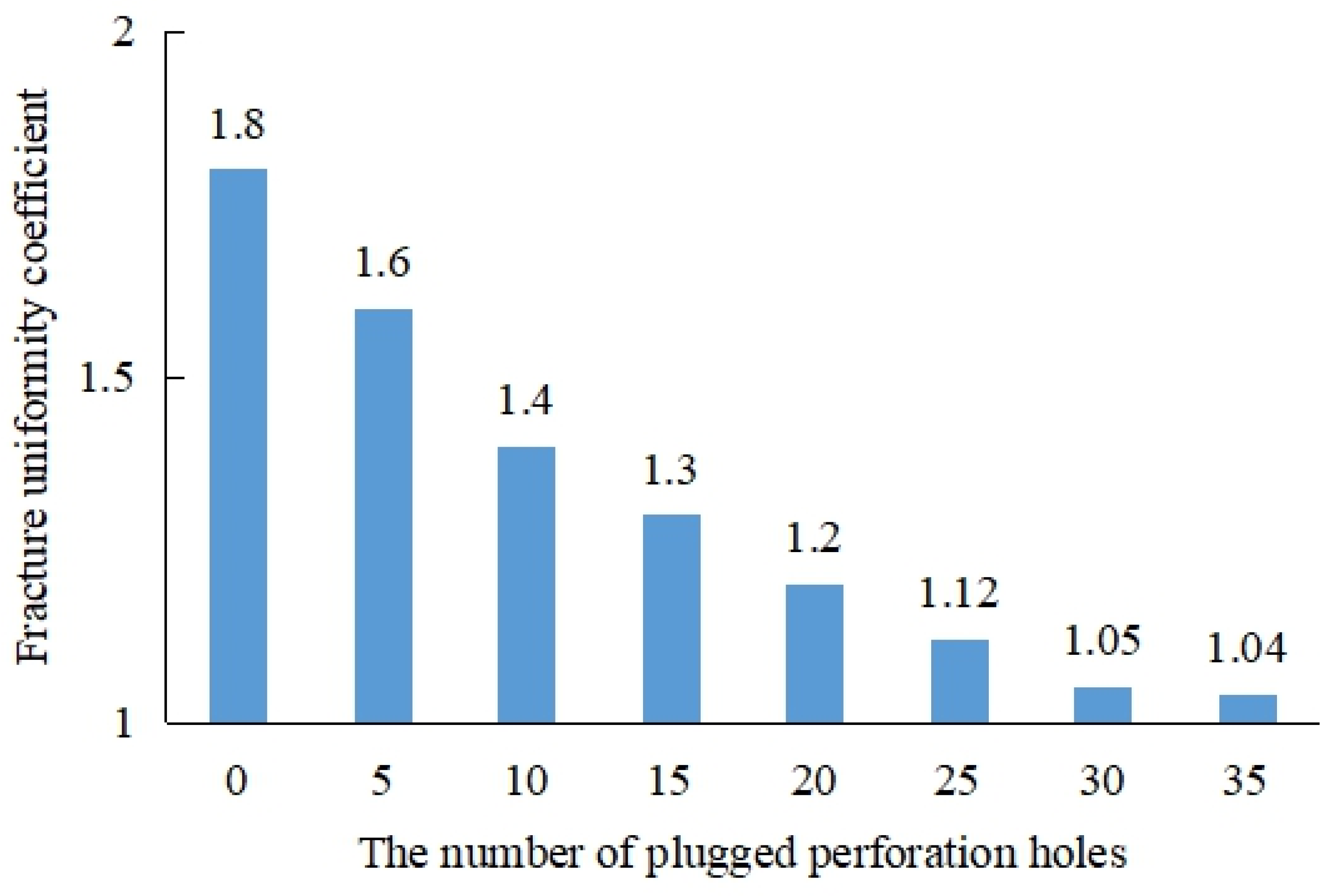

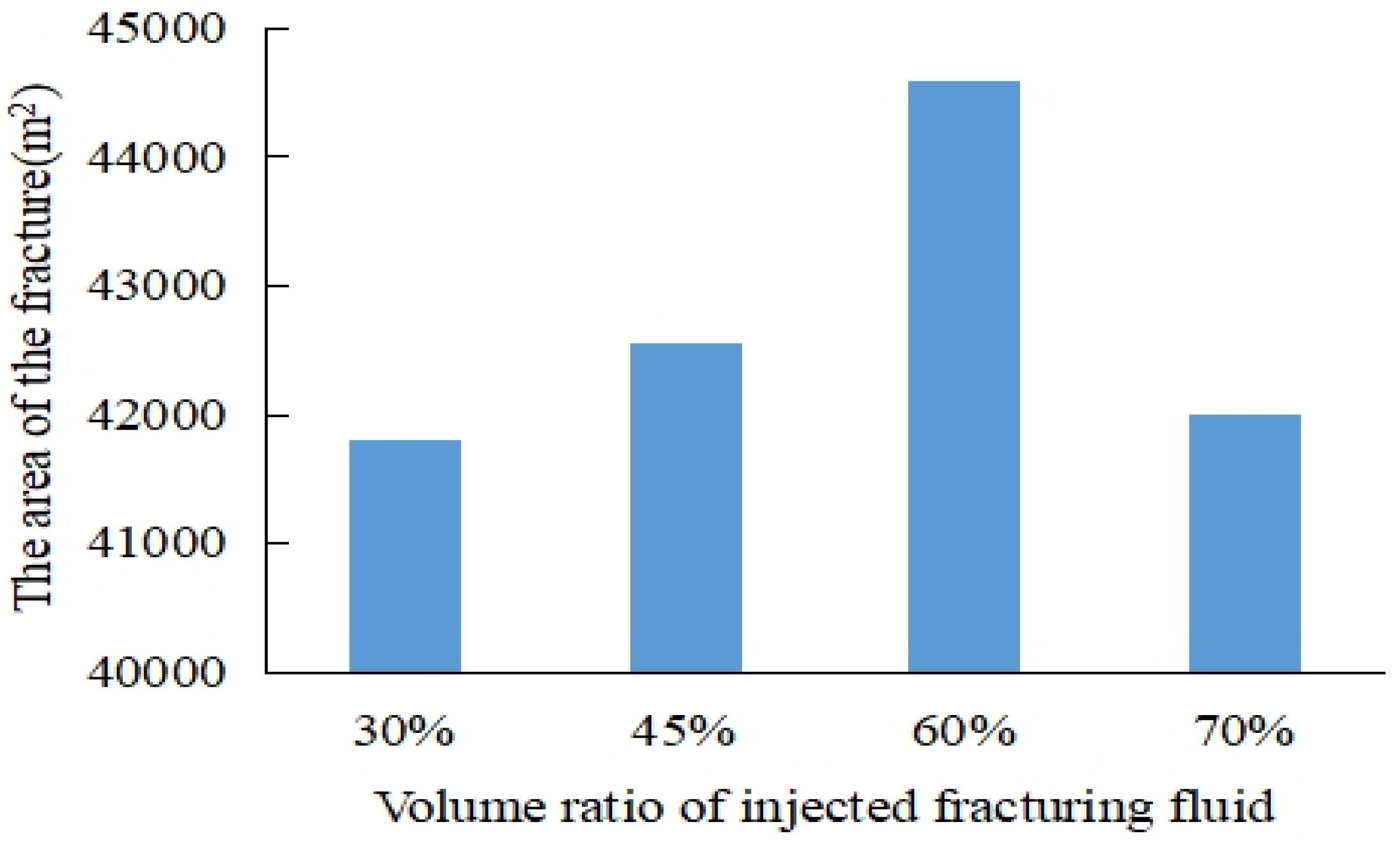
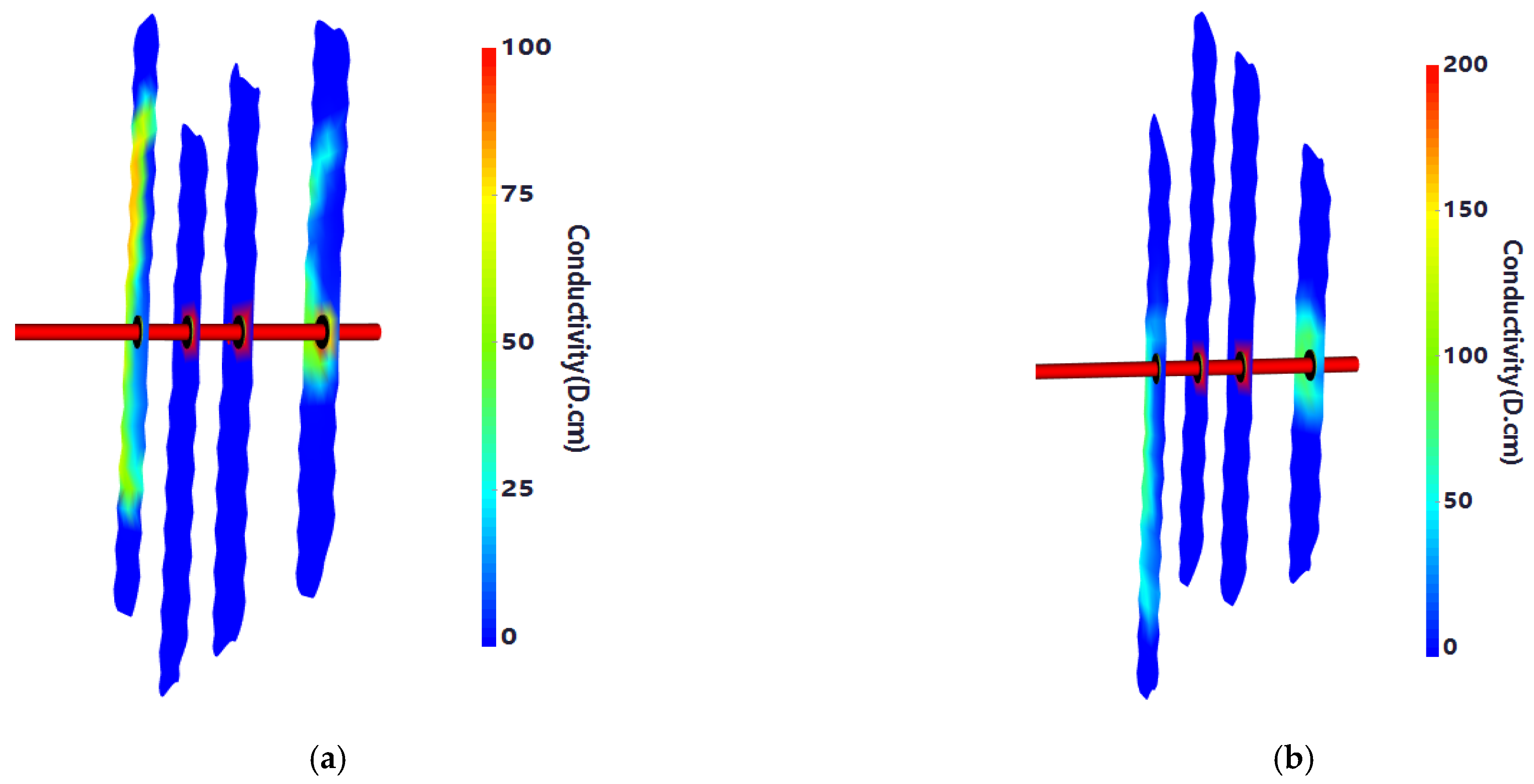

| Porosity, % | 3.6 |
| Permeability, mD | 0.052 |
| Young’s modulus, 104 MPa | 4.15 |
| Poisson’s ratio | 0.21 |
| Horizontal maximum principal stress, MPa | 54.3 |
| Horizontal minimum principal stress, MPa | 46.1 |
| Fracturing fluid injection displacement, m3/min | 18 |
| Reservoir thickness, m | 10 |
| Compressive strength of rock, MPa | 405.5 |
| Fracturing fluid viscosity, mPa·s | 10 |
Disclaimer/Publisher’s Note: The statements, opinions and data contained in all publications are solely those of the individual author(s) and contributor(s) and not of MDPI and/or the editor(s). MDPI and/or the editor(s) disclaim responsibility for any injury to people or property resulting from any ideas, methods, instructions or products referred to in the content. |
© 2025 by the authors. Licensee MDPI, Basel, Switzerland. This article is an open access article distributed under the terms and conditions of the Creative Commons Attribution (CC BY) license (https://creativecommons.org/licenses/by/4.0/).
Share and Cite
Wang, Y.; Yang, J.; Yuan, Q.; Chen, W.; He, Y.; Liu, Z.; Lv, Z.; Li, Z.; Fan, J.; Wang, T.; et al. Mechanistic Analysis and Multi-Factor Coupling Optimization of Temporary Plugging Fracturing in Shale Oil Horizontal Wells: A Case Study from the Sichuan Basin, China. Processes 2025, 13, 1134. https://doi.org/10.3390/pr13041134
Wang Y, Yang J, Yuan Q, Chen W, He Y, Liu Z, Lv Z, Li Z, Fan J, Wang T, et al. Mechanistic Analysis and Multi-Factor Coupling Optimization of Temporary Plugging Fracturing in Shale Oil Horizontal Wells: A Case Study from the Sichuan Basin, China. Processes. 2025; 13(4):1134. https://doi.org/10.3390/pr13041134
Chicago/Turabian StyleWang, Yang, Jian Yang, Qingyun Yuan, Weihua Chen, Yiguo He, Zhe Liu, Zefei Lv, Zhengyong Li, Jinming Fan, Tao Wang, and et al. 2025. "Mechanistic Analysis and Multi-Factor Coupling Optimization of Temporary Plugging Fracturing in Shale Oil Horizontal Wells: A Case Study from the Sichuan Basin, China" Processes 13, no. 4: 1134. https://doi.org/10.3390/pr13041134
APA StyleWang, Y., Yang, J., Yuan, Q., Chen, W., He, Y., Liu, Z., Lv, Z., Li, Z., Fan, J., Wang, T., Chen, W., & Tang, X. (2025). Mechanistic Analysis and Multi-Factor Coupling Optimization of Temporary Plugging Fracturing in Shale Oil Horizontal Wells: A Case Study from the Sichuan Basin, China. Processes, 13(4), 1134. https://doi.org/10.3390/pr13041134






